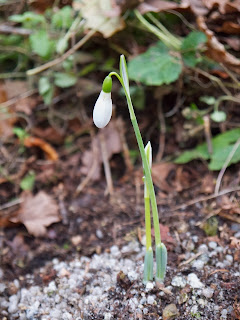While snowdrops are quintessential ingredients of late winter and early spring, with the flowering of naturalised common snowdrops Galanthus nivalis usually reaching a peak during the first 10 days of February in this garden, selection of early and late-flowering species and their cultivars can extend the season over five months or more.
A few years ago I planted three bulbs of Galanthus elwesii Hiemalis Group that came originally from Beth Chatto's nursery and which are renowned for their early flowering. It has taken a while for them to settle down, and – since no self-respecting snowdrop appreciates having a soggy bottom during its dormant season – they basically sat and sulked for several years as one wet summer followed another. But things are looking up and it's again (as so much in gardening) all down to the weather, I reckon.
The cold spring of 2013 made for a prolonged snowdrop growing season here in Devon, resulting in fat, healthy bulbs, which then benefited from a warm, pretty dry summer dormancy. Anticipating that the mild, wet autumn would have encouraged early-flowering snowdrops into an advanced stage of growth, I went in search among the still quite leafy borders on Saturday. There to greet me was an already nodding flowerhead of Galanthus elwesii Hiemalis Group (left) with further sky-pointing buds to follow.

Elsewhere, I came across G. e. 'Peter Gatehouse' in flower (right) – each bulb's pair of leaves barely breaking the surface and seeming to clasp the base of the flowerstalk. I only planted Mr G last year, so I'm glad that he seems to be making himself at home. Spring already feels like a more tangible prospect.

No comments:
Post a Comment